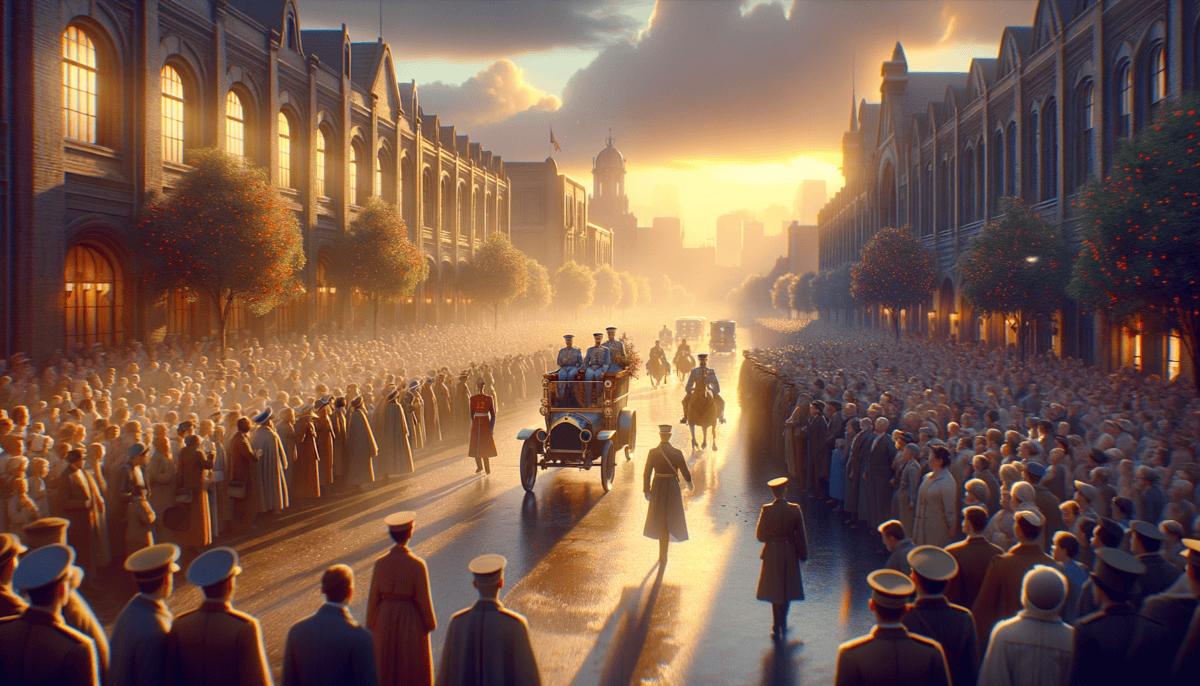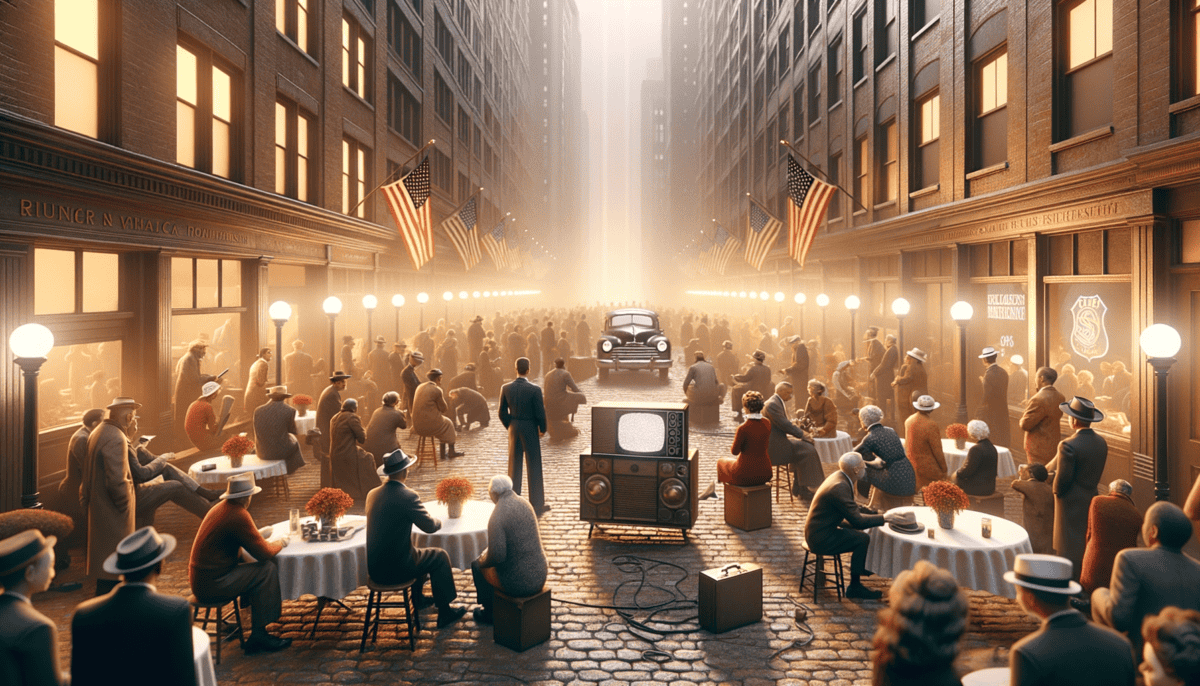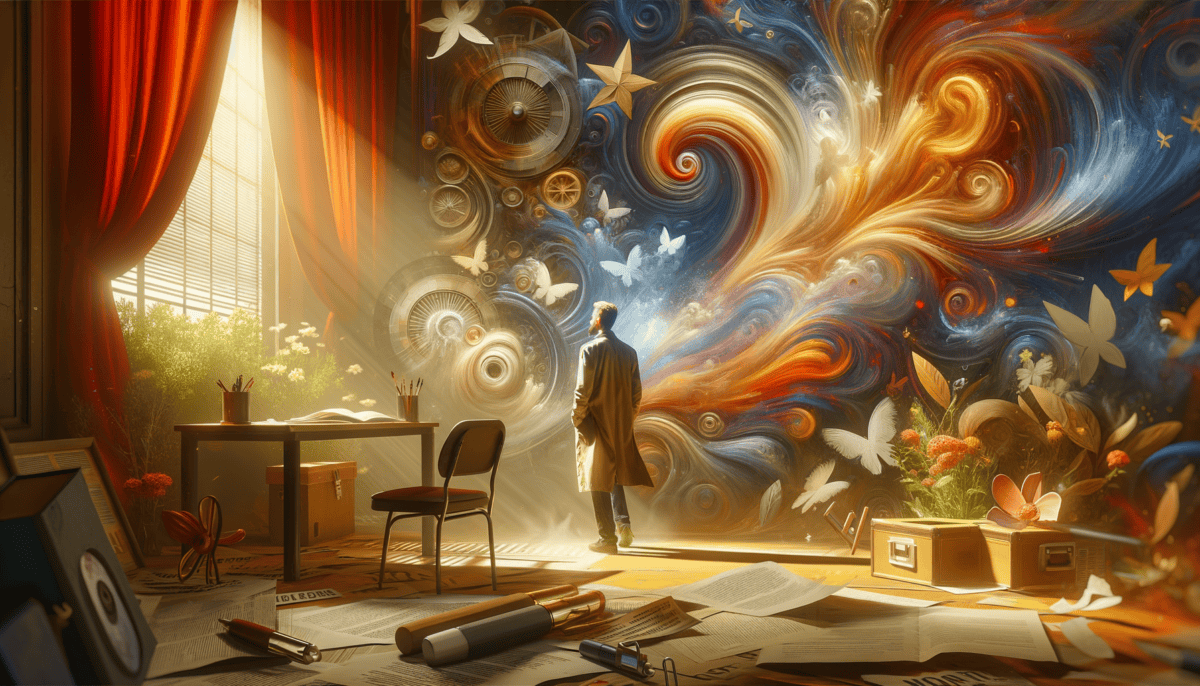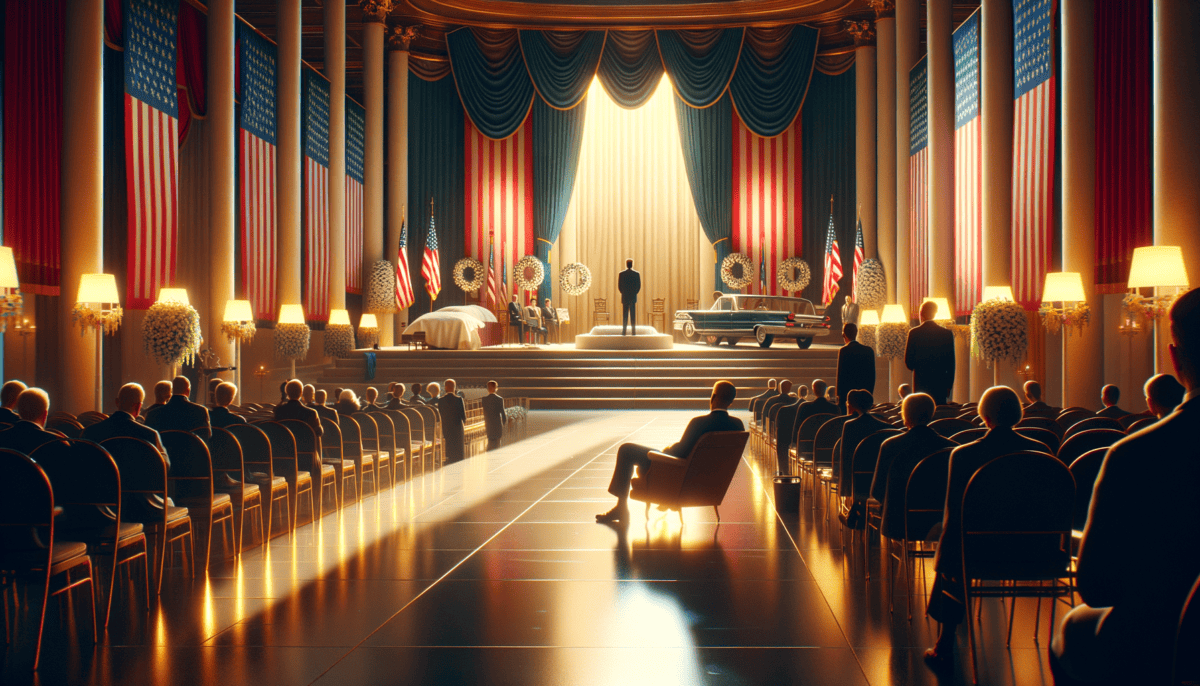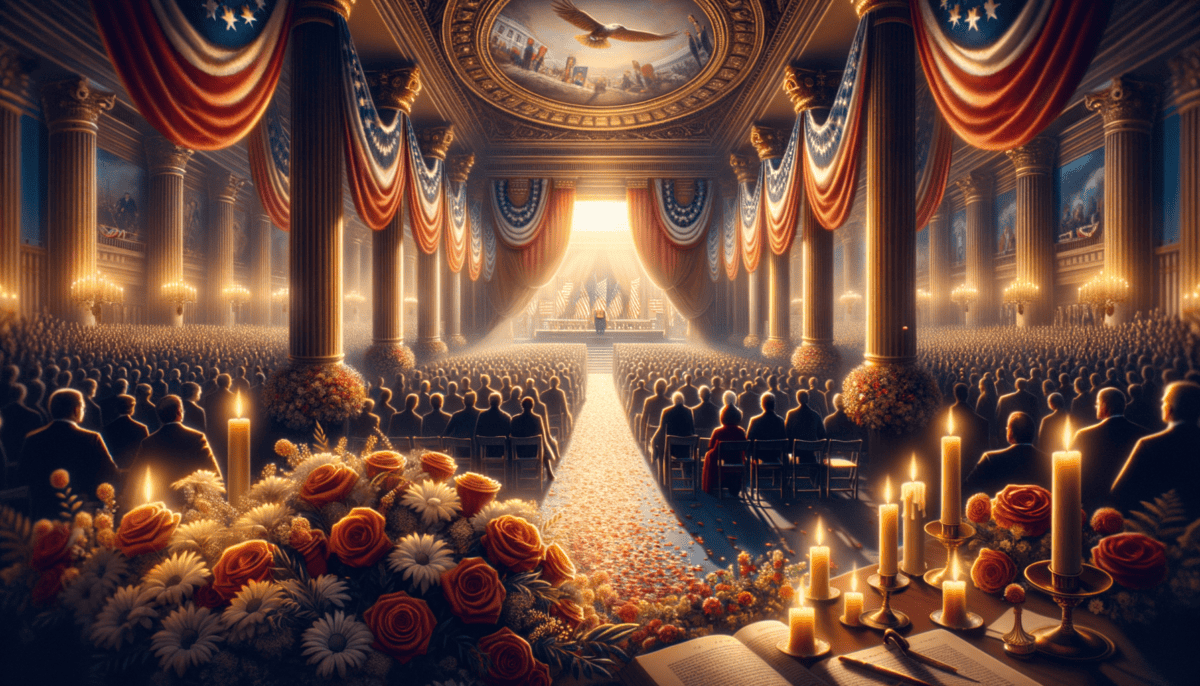Bright Morning in Dallas
The sun rose golden over Dallas on November 22, 1963. It was a perfect autumn day – not too hot, not too cold. Just right for a special visit from President John F. Kennedy and his wife Jackie.
Little Sally Thompson bounced excitedly on her tiptoes, holding tight to her mother's hand. "Mommy, when will they come?" she asked, her eyes scanning the crowd gathering along Main Street.
"Soon, sweetheart," Mrs. Thompson smiled. "The President's plane should land any minute now."
All around them, people chatted happily. Some waved small American flags, while others held up signs saying "Welcome to Dallas!" The whole city seemed to sparkle with excitement.
“I’ve never seen Dallas so happy,” whispered Mr. Jenkins, the neighborhood baker. “Everyone wants to see our young President and his beautiful wife.”
At Love Field airport, Air Force One touched down smoothly on the runway. The big plane gleamed silver in the morning light. As the door opened, everyone held their breath. First came Jackie Kennedy, looking pretty in her pink suit. Then President Kennedy appeared, tall and smiling, waving to the crowd.
Important things to know about that special morning:
- The weather was sunny and mild – perfect for a parade
- Thousands of people lined the streets to see the President
- Jackie Kennedy wore her famous pink suit
- The President planned to give a speech later that day
- Everyone felt happy and excited to welcome them
Little Tommy Martinez stood with his class from Dallas Elementary School. His teacher, Miss Roberts, helped the children make a banner that said "We Love JFK!"
"Look how handsome he is!" said Tommy's friend Maria. "And Mrs. Kennedy looks just like a princess!"
The presidential couple climbed into their dark blue Lincoln Continental car. The top was down so everyone could see them better. Other cars filled with security guards, reporters, and important people lined up behind them.
Governor John Connally and his wife Nellie joined the Kennedys in their car. As the motorcade began moving through downtown Dallas, people cheered and threw confetti. It looked like snow falling in the warm Texas sunshine.
"Wave to the people, John," Jackie said softly to her husband. And he did, that famous Kennedy smile lighting up his face as he acknowledged the crowds.
The clock struck noon in Dallas.
Secret Service Agent Roy Kellerman checked his watch and radioed ahead: "Timeline on schedule. Crowd behavior normal. All clear."
But somewhere in the city, dark plans were already in motion. The happiness of that bright morning wouldn't last much longer. The hands of time ticked steadily forward, moving America toward a moment that would change everything.
The morning sun continued to shine on Dallas, not knowing that by afternoon, its golden light would fall on a very different world…
The crowds grew larger as the motorcade made its way through the city. Children sat on their parents' shoulders for a better view. Office workers pressed against windows, hoping to catch a glimpse of their President.
"God bless you, Mr. President!" someone shouted from the crowd. JFK turned and waved in that direction, his face bright with optimism and energy.
Nobody could have guessed that these were some of the last waves, the last smiles, the last moments of peace before everything changed. The bright morning in Dallas kept rolling forward, carrying everyone toward an appointment with history that would break America's heart.
The Fatal Journey
The presidential motorcade moved slowly through downtown Dallas. Shiny black cars rolled down the street like a parade. People lined both sides, waving and smiling.
“Look, they’re coming!” little Bobby Wilson shouted from his dad’s shoulders. The special car carrying President Kennedy came into view. Its dark blue paint sparkled in the sun.
“The President looks so happy,” Bobby’s dad said. “See how he waves to everyone?”
The big clock on the bank building showed 12:29 PM. The cars turned onto Elm Street near a big brick building called the Texas School Book Depository. Tall trees made cool shadows on the road.
Nellie Connally turned to President Kennedy and smiled. “Mr. President,” she said, “you can’t say Dallas doesn’t love you!”
Then everything changed in just a few seconds:
- A loud bang echoed through the plaza
- People started screaming
- More loud sounds followed
- The presidential car speeded up
- Police motorcycles raced around
Mary Thompson, a nurse watching nearby, felt her heart jump. “Something’s wrong,” she whispered. She saw Mrs. Kennedy reach for her husband. The car zoomed away toward the hospital.
The sunny day suddenly felt dark and cold.
Police officer James Mitchell was riding his motorcycle next to the President’s car when he heard the noise. “At first I thought it was a firecracker,” he said later. “Then I knew it was much worse.”
Little Sarah Rodriguez held tight to her mother’s skirt. “Mommy, why is everyone crying?” she asked. Her mother couldn’t answer. She just hugged Sarah close.
Secret Service agents jumped into action. Their radios crackled with urgent messages. The presidential car raced toward Parkland Hospital, its engine roaring loud.
Back in Dealey Plaza, people stood frozen. Paper confetti still floated in the air. Happy signs lay dropped on the ground. The clock on the bank building now showed 12:31 PM. In just two minutes, America had changed forever.
Police cars screamed down the streets with sirens wailing. Officers started asking questions: “Did anyone see where the shots came from? What did you hear? What did you see?”
“I was looking right at them when it happened,” said Mr. Jenkins, his voice shaking. “One minute everything was perfect, and the next…”
The warm Texas breeze still blew through Dealey Plaza. But now it carried whispers of fear and sadness. The happy morning had turned into a terrible afternoon.
When Everything Changed
The clock showed 1:33 PM when Walter Cronkite appeared on TV screens across America. His voice shook as he spoke the words nobody wanted to hear.
“From Dallas, Texas, the flash apparently official: President Kennedy died at 1:00 PM Central Standard Time.”
In homes, schools, and offices, people stopped what they were doing. Mrs. Anderson’s second-grade class in Ohio sat very quiet when their teacher started crying.
“Mommy, why are you sad?” little Tommy asked, watching his mother stare at the TV. She pulled him close and whispered, “Someone very important to our country is gone.”
The news spread quickly in different ways:
- Radio stations stopped playing music
- TV shows were canceled
- Church bells rang everywhere
- Schools sent children home early
- Stores closed their doors
In New York, Billy Martinez watched his dad lower their American flag to half-staff. “What does that mean?” Billy asked.
“It means our country is very sad today,” his father explained softly.
Vice President Johnson took the oath to become the new president. Mrs. Kennedy stood next to him, still wearing her pink suit. Her face was very sad but brave.
The weather stayed sunny in Dallas, but the whole city felt dark. Police cars raced around with sirens screaming. Officers looked everywhere for clues about what happened.
Little Sarah watched her big brother Jimmy take down his President Kennedy picture from their bedroom wall. “Are you throwing it away?” she asked.
“No,” Jimmy said, hugging the picture. “I’m going to keep it forever to remember him.”
In Washington D.C., government workers left their offices early. Many couldn’t stop crying. Some held hands as they walked home, trying to comfort each other.
Mrs. Kennedy rode back to Washington with her husband’s body. She wouldn’t change her clothes, even though they were dirty. “I want them to see what they did,” she said quietly.
That night, millions of families sat together watching the news. Parents tried to explain to their children what happened. Everyone wondered how things would be different now.
As the sun set, America wasn’t the same country it had been when the sun rose that morning. Something big had changed, and everyone could feel it.
The Man Behind the Gun
In a tiny room at the Dallas Police Station, a man named Lee Harvey Oswald sat quietly. His face showed no feelings as police officers asked him lots of questions.
“I didn’t shoot anybody,” Oswald said over and over. But the police had found something important – a special gun hidden in the book building.
Little Bobby watched the news with his dad in Chicago. “Who is that man?” he asked, pointing at Oswald’s picture on TV.
“That’s the person they think hurt our president,” his father answered softly.
Before this day, Oswald lived a strange life. He moved a lot and even lived in Russia for a while. He had trouble making friends and keeping jobs.
The police found these interesting things about Oswald:
- He worked in the book building where the shots came from
- He knew how to use guns from being in the Marines
- He ran away from the building right after the shooting
- He had strange ideas about politics
- He was carrying a fake ID when they caught him
“Why would someone want to hurt President Kennedy?” Sarah asked her mom during dinner.
Her mother sighed. “Sometimes people do bad things that we can’t understand, honey.”
Meanwhile, some people started saying maybe Oswald didn’t work alone. “It seems too big for just one person,” they whispered. These ideas would later be called conspiracy theories.
Two days after the shooting, something unexpected happened. While police were moving Oswald to a different jail, a man named Jack Ruby jumped out of the crowd.
“Bang!” The sound echoed through the basement garage.
On TV screens across America, people watched in shock as Ruby shot Oswald. Now the man who might know the most about President Kennedy’s death was gone too.
Tommy’s teacher tried explaining it to her class the next day. “Sometimes we don’t get all the answers we want,” she said gently. “But we can still remember President Kennedy and try to be good people like he wanted us to be.”
As night fell over Dallas, police officers finally went home to their families. They looked tired and sad. The case wasn’t closed – it was just getting more complicated.
Even today, people still talk about what really happened on that sunny day in Dallas. The mystery of Lee Harvey Oswald became part of the bigger story of how America changed forever.
Tears for a President
The sun rose over Washington, D.C. on a cold November morning. The White House, usually bright and busy, seemed quiet and sad. Black ribbons hung from the doorways. ️
Little Mary watched as her mom wiped tears from her eyes while folding laundry. “Why are you crying, Mommy?”
“The whole country is crying today, sweetie. We’re getting ready to say goodbye to our president.”
People lined up for miles to pay their respects. Some walked all night just to say farewell to President Kennedy.
In the White House, Jackie Kennedy stayed strong for her children. Caroline, just 5 years old, held her little brother John-John’s hand. He would turn 3 on Monday – his father’s funeral day.
“Where’s Daddy?” John-John asked.
Jackie hugged him close. “Daddy’s gone to heaven, but he’s watching over us.”
- Church bells rang in Rome
- Paris turned off the Eiffel Tower’s lights
- London’s Big Ben chimed 46 times – once for each year of JFK’s life
- Even in Moscow, people left flowers at the U.S. Embassy
- Children in Africa drew pictures for Jackie
Outside the Capitol building, Tommy waited with his dad in the long line. “Look how many people came,” he whispered.
His father nodded. “President Kennedy belonged to all of us. That’s why we’re all here to say goodbye.”
The funeral procession moved slowly through Washington’s streets. A riderless horse named Black Jack followed the casket, boots backward in the stirrups – a special honor for fallen leaders.
In schools across America, teachers helped students understand what was happening. “President Kennedy wanted us to be brave and kind,” Mrs. Thompson told her class. “We can honor him by being just that.”
Sarah raised her hand. “Can we write letters to Caroline and John-John?”
“That’s a wonderful idea,” Mrs. Thompson smiled through her tears.
As the sun set on the funeral day, a small flame was lit at Arlington Cemetery. This eternal flame would burn forever, helping people remember President Kennedy.
Vice President Johnson, now the new president, spoke to the nation: “Let us continue,” he said, promising to keep working on the good things President Kennedy had started.
That night, millions of candles glowed in windows across America, lighting up the darkness with hope for tomorrow. The country would never forget, but it would grow stronger together.
A Legacy of Hope
The morning sun sparkled on the eternal flame at Arlington Cemetery. Little Bobby stood with his grandfather, watching the dancing light.
“Grandpa, tell me about President Kennedy again,” Bobby whispered.
“He dreamed big dreams for America, kiddo. He wanted us to go to the moon, to help people who needed help, and to make the world better.”
The years after President Kennedy died brought many changes to America. His dreams didn’t die with him – they grew bigger and stronger.
• Americans walked on the moon
• More people got to vote
• Kids from all backgrounds could go to school together
• People worked harder to make peace
• The country became kinder and stronger
Sarah, now a teacher herself, showed her students pictures of the 1960s. “After President Kennedy died, something amazing happened,” she explained. “People remembered his words about being brave and helping others.”
“Did they catch the bad person who hurt him?” a student asked.
Sarah nodded gently. “Lee Harvey Oswald was caught, but there are still many questions about that day. Sometimes the hardest thing is not knowing everything.”
In the Kennedy Library, Maria watched old videos with her mom. “Look how happy people were when he spoke!” she exclaimed.
“That’s because he gave people hope,” her mom explained. “He told us we could do anything if we worked together.”
The Secret Service made big changes too. They learned new ways to keep presidents safe, so what happened to President Kennedy would never happen again. ️
Even today, scientists and historians study what happened that day in Dallas. They use new technology and find new clues. But the most important thing isn’t solving the mystery – it’s remembering the hope President Kennedy gave America.
Back at Arlington, Bobby placed a small American flag near the flame. “I wish I could have met him,” he said.
His grandfather smiled. “In a way, you have. Every time you dream big dreams, help others, or stand up for what’s right, you’re carrying on his work.”
As they walked away, the eternal flame danced in the breeze, a forever light reminding us that hope never dies. President Kennedy’s story didn’t end in Dallas – it lives in the hearts of everyone who believes in a better tomorrow.


